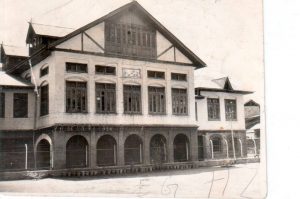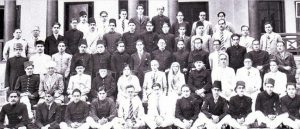Peace Watch » Editor's Take, Kashmir-Talk, Point of view » Showcasing History – Rebuilding Citadel of Kashmir Freedom Struggle
Showcasing History – Rebuilding Citadel of Kashmir Freedom Struggle
PUNCHLINE
Showcasing History
By
Z.G. Muhammad
 Thirty-three years back, in December 1985, by sheer luck, I had landed in Paris. The State
Thirty-three years back, in December 1985, by sheer luck, I had landed in Paris. The State  then was ruled by a ‘defection’ government. It was a government of just eleven legislators turned ministers who had deserted their party for ministerial berths and earned sponsorship from New Delhi. In this fifteen-month old government, bureaucracy ruled the roost. In one of the meetings, I also won a favor of a senior bureaucrat- a visit to a couple of European countries.
then was ruled by a ‘defection’ government. It was a government of just eleven legislators turned ministers who had deserted their party for ministerial berths and earned sponsorship from New Delhi. In this fifteen-month old government, bureaucracy ruled the roost. In one of the meetings, I also won a favor of a senior bureaucrat- a visit to a couple of European countries.
My love for art and literature in Paris took me to Centre Georges Pompidou, a queer architecture, with huge pipes on the building’s façade giving it look of an oil refinery. In this 7-story, 1.1 million square feet ‘non-traditional multicultural complex of art and literature, I was excited on finding in its library a small section marked ‘Cashmere’, with books on Kashmir on its shelves. If my memory supports, it was on the fifth floor of the building. Then, I had written an article on this Centre in a Jammu newspaper dreaming about having a comparable Centre or a museum in Srinagar for showcasing the history of persecution of the people of our land by alien rulers and struggle of our ancestors against these marauders. The story of Beggar– something worst than conscription and more brutal than corvee, with famished people with mounds of load hoisted on their shoulders and an extra-pair of hay sandals hanging around their necks like collars of slavery climbing up razor-thin cliffs steeply falling to both sides, with many dying out of starvation on way to Gilgit and wild crows hovering over skies ready to feast upon them would more powerfully convey sufferings of our ancestors through painting on the walls of the Centre than thousand of words. The blow-ups of black and white pictures of turbaned soldiers, with leather girdles around their waists and long whips in their hands coercing people to work in farms without wages clicked by the European visitors in the museum, would instantaneously and powerfully tell horrendous stories of our ancestors to younger generation, who largely are oblivious to their past.
Some days back, on reading a debate on the social network generated by a black and white photograph of a two-story iconic building built almost nine decades back then named as Mujahid Manzil torched in the early 1990s, I was reminded of my visit to this Centre in Paris. I equally remembered an article I had written in a Jammu newspaper dreaming about having a similar Centre in our land.
Thirty years after its burning down the Mujahid Manzil, the citadel of our resistance movement has not been reconstructed and the premises are occupied by the paramilitary forces. Many times, questions like why this building was burnt to ashes and who burnt it bothered me. The instant answer that often came to my mind was, it was perhaps torched because boys in early nineties identified it with the ruling party- of course, a bête noire that they rightly believed was in the dock for its role at important junctures in our history- 1938, 1947 and 1975 and responsible for perpetuating uncertainty and innumerable sufferings to the multitudes. Nonetheless, many other questions baffled me and made me realize that the answer to this question was not as simple as a sums question in class one. Why was my alma mater Islamia College with a long history of producing best graduates for decades and having one of the richest library and rarest manuscripts torched? Why one of the topmost Islamic seminary the Madinat-ul-Uloom, at Hazratbal with rarest of manuscripts and books on theology set on fire. It had been a fountainhead of Islamic learnings for many decades and had produced hundreds of Islamic scholars.
The debate on social network the Facebook about the Mujahid Manzil with some posts justifying it’s burning down and opposing its reconstruction made me realize that the ‘fault, dear Brutus, is not in our boys, but in ourselves’, that we have failed to showcase the history of the land for our new generations, thus yielded space for the powers inimical to the cause of people of the land to construct ‘hegemonic discourses’. The ignorance of history in our new generation provides rich substratum for the “dominant discourse”- the discourses of the state to thrive upon.
It was amazing to note, that majority did not know the story behind the construction of this totem of resistance, its importance to our narrative and its place in our struggle. Moreover, they did not know that it did not belong to a political party but to the people of Jammu and Kashmir- of course, the undivided state. It would be worthwhile to recapitulate the story of the birth of this historical building for younger readers, who have not seen it resounding with slogans challenging the bastions of hubris and power. Not in the thirties and the forties only but in the sixties and the seventies also when it had once again turned into a bastion of the people’s struggle- for the right to decide the future.
From mid-twenties, in our battle for justice, fair play and ending the bigoted rule we were not alone. Almost entire Urdu press of Punjab supported our movement. Twelve days after soldiers of the Maharaja killed unarmed people outside the Srinagar Central Jail, On July 25, 1931, prominent citizens of Punjab assembled at the Fair View, the residence of Sir Zulfikar Ali Khan in Shimla and founded the All India Kashmir Committee to articulate the cause of the people of Jammu and Kashmir in British India. Those who had gathered at Shimla included Sir Dr. Mohammad Iqbal, Mirza Bashir-ud-Din, Maulana Mohammad Ismail Ghaznavi, Khawaja Hassan Nizami and Abdul Rahman Dard. These people were joined by scores of eminent intellectuals, political and religious leaders in British India.
The mobilization of public opinion by the Kashmir Committee had its impact on the Maharaja of Kashmir. Its activities coupled with other organization in Punjab had worked as a catalyst in bringing down the Maharaja from the cliff of hubris and make him appoint he Glancy Commission. The appointment of commission and implementation of its recommendations more particularly allowing freedom of ‘press, platform, and association’ was a leap forward for the movement of the Muslims of Jammu and Kashmir. On 15, 16 and 17 October a three days convention was held on a big ground adjacent to Shahi Masjid to launch the first political organization of Muslims of the State and it was named as Jammu and Kashmir Muslim Conference. It was on these grounds first major political resolutions articulating the demands of Muslim of the State were adopted. Moreover, the flag of the party was for first time unfurled by representatives of the All India Kashmir Committee Walliullah Zain-ul-Abidan. One year after the Mujahid Manzil- the first house of resistance was constructed on the same ground through public donations. From M.A. Jinnah who addressed the leaders of Muslim Conference in 1936, there has been hardly any other important leader of the Indian Sub-Continent who till 1947 did not visit the Mujahid Manzil.
The house with such a historical past needs to be rebuilt and converted into a museum for showcasing the history of the land and struggle of its people against marauders, invaders, and oppressors.
Published in Greater Kashmir on 5-2-18
Views and comments can be send on zahidgm@gmail.com
Filed under: Editor's Take, Kashmir-Talk, Point of view







